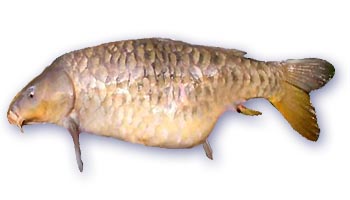 |
 |
The colourful varieties of Koi carp available today are a strain which was first bred 160 years ago in Japan from a naturally occurring mutation. Carp have been cultured in Europe since the 13th century, often as a food and sport fish for monasteries. Since they can survive well in small pools, they were often grown in moats and ornamental ponds. Carp are now found throughout the world, except for the polar regions and most oceanic islands.
The Latin name for the carp is Cyprinus carpio. The carp is one of the most commonly found fish on the planet. It has been utilised throughout the centuries by many different cultures. Today it is still farmed in Europe, Asia and the Middle East. To reinforce this statement we can see that in 1990 around 5 ½ million tons of carp was amassed by aquaculture of the species.
Originating in a region of central Asia characterised by hot summers, cold winters and low rainfall, they inhabit wide, slow-flowing rivers and warm lakes. Carp were introduced to China, Japan and Italy in ancient times. From Rome they spread to Greece and southern Europe. They arrived in central Europe in the 12th century and England in the 14th century. The earliest recorded cultivation was in China in 475 BC.
As any creature that has been bred in captivity for commercial purposes, the Carp is found in a number of different strains that have been produced for various purposes. Just as every variety of dog are the same species, the Carp is the same. One species, many varieties or strains. All of the Carp mentioned here are of the same species: Cyprinius Carpio. Below are the ancestors of the Koi that we see today. You will be able to clearly see how some of the color and scalation patterns have developed from these original Carp.
Black carp or "Magoi"

The black carp are one of the main carp strains that develped the koi
we see today.
They are very similar to the common carp and basically differ in color
and some body conformation.
Common carp

Common carp are covered, completely, with uniformed rows of scales.
The fish appear a dark brown color when viewed in the water from above,
but when seen side on,
the scales on the fishes flanks show a bright golden color, depending
on water quality.
Mirror carp

Mirror carp were selectively bred from Common carp to be free of scales
(nacreous),
to save de-scaling before cooking. Its body is `sprinkled` with reflective
scales of varying sizes and
no set pattern. Each mirror carp has its own personal scale pattern,
no two fish are the same.
The scale patterns are as individual as fingerprints and fish can be
identified by them.
Leather carp

The leather carp are completely free of scales.
Originally bred by commercial breeders to provide a fish that would
be easier to prepare for market.
A carp totally free of scales is incredibly rare. Some anglers make
an exception, for the
odd small scale across the fishes back or at the base of the dorsal.
Linear Mirror

Linear mirror are simply carp, with a slightly more "organized" scale
pattern.
The linear carp has just two rows of scales along each flank.
One row runs the full length
of the fishes body, along its lateral line, and the other runs from
just behind the head,
along its back and along the dorsal fin. There are no "misplaced" scales.
Koi Carp

Selectively bred in Japan to produce fish of outstanding color
and normally kept in large outdoor pools. The term "Koi Carp" when
used by anglers, is used to include all Koi,
regardless of coloration patterns, but to Koi breeders and fanciers,
every Koi belongs to a specific "group".
Each fish can be identified by experts, by coloration patterns.
Some of these fish can be worth thousands of dollars, and not necessarily
in comparison to size!
These fish have been stocked in limited fisheries, by people "releasing"
unwanted pets,
flooding and stocking programs. Not found in too many waters, due to
their value.
Fully scaled mirror

A mirror carp with body completely covered in large non-uniform scales.
They are the rarest carp strain.
Ghost Koi

Bred from crossbreeding Commons, Mirrors or Leathers with ornamental
Koi Carp.
Some anglers report that these are a harder fighting variety of fish.Ghost
Koi can take on the scale patterns
of any of the fish above, but show colorings like the one shown. The
`brightness` and shades of the
markings can vary greatly, from very bright and apparent, to dull and
not so apparent.
The Wild carp


The Wild carp is not unlike the Common carp in colour and scale pattern,
sometimes leading to confusion between them. A true "wildie" is much
slimmer in comparison,
and has a body shape a little similar to that of the Barbel.
Two examples are shown, one in bronze color and one in silver.